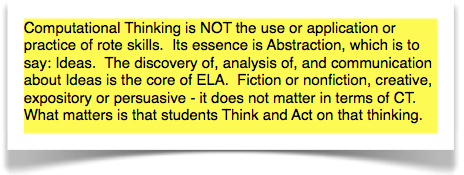I am deeply reading Hoban's brilliant Riddley Walker. That is a key to my frame of mind. As I looked today at images of elementary school reading Anchor Maps - totally independent of Riddley - it occurred to me that every single one of those visual charts was applying basic principles of computational thinking (CT) to the reading task, whether it be of fiction or nonfiction. In fact, I was applying the CT principles to my reading of my very complex novel.
It turns out that the same principles also apply to writing tasks. Not surprising - the human brain is, after all, a computer that outputs (or prints out) 24/7.
What is CT? The best, simple working definition for literacy purposes is this: "Computational thinking is taking an approach to solving problems, designing systems and understanding human behaviour that draws on concepts fundamental to computing" (Jeanette M. Wing, Computational thinking and thinking about computing).
A simple overview of CT for education is provided by iste. Other resources can be found at Google's Exploring Computational Thinking site.
An overview of the CT problem-solving method (adapted from Jeanette M. Wing's Viewpoint: Computational Thinking) is important. As you read the steps, think about your lessons and activities:
- What is the difficult problem?
- How is it difficult to solve?
- Consider the character's situation, background, resources, constraints
- Consider the text - vocabulary, sentence structure, voice
- Search, search, search - collect large amounts of data
- Reformulate the problem into one we know how to solve, preferably by using computers (see chart below)
- Reduction
- Decomposition
- Embedding
- Transformation / modeling
- Simulation
- Design a system to solve the reformulated problem
- Be curious
- Conceptualize, Abstract
- Imagine
- Think virtually, not realistically (daydream)
- Use invariants - elements that will not change no matter what solution is applied (e.g. spelling, paragraph elements, the restrictions of the prompt, the list of known literary terms)
- Ask: Is the solution good enough?
- Is it aesthetically pleasing?
- Is it correct?
- Is it efficient?
- Is it simple and/or straightforward in its design?
- Can it be automated or expressed in algorithms?
- Apply the solution to other problems
- "The essence of computational thinking is abstraction." (Wing)
- "Computational thinking is thinking in terms of prevention, protection, and recovery from worst-case scenarios [illiteracy, low test scores] through redundancy [repetition of same and increasingly complex texts and writing], damage containment [knowledge of individual student's progress, holding students to high standards], and error correction [learning]." (Wing)
- "Computational thinking is using heuristic reasoning to discover a solution [seeking a quick, workable solution to the problem at hand]." (Wing)
- Computational thinking is "having the confidence we can safely use, modify, and influence a large complex system [a text, a body of literature, a concept discussed in literature, how to write an essay] without understanding its every detail." (Wing)
Isn't this what deep learning is all about? I don't find it at all odd or ironic that a concept that comes from the world of computer science has been applied in (not to) ELA since literature study began. If anything, ELA is the field most closely tied to the "human behavior" elements of CT. Textual analysis may be the root of CT thinking (I like to think so).
So it is logical that, for ELA teachers, this 21st century toolkit is largely already embedded in what we do - no matter what tools we use. You don't have to change anything to use CT.
Oh, and remember that the brain is a tool.
What exactly does computational thinking look like in the world of ELA? Some suggestions are in the tables below, but there are hundreds more. By conscientiously applying these Elements and Concepts to teaching, we teach better. Learning is harder for all, but better.
I repeat:
- Ask: Is the solution good enough?
- Is it aesthetically pleasing?
- Is it correct?
- Is it efficient?
- Is it simple and/or straightforward in its design?
Are we trying too hard to be 21st Century?











No comments:
Post a Comment